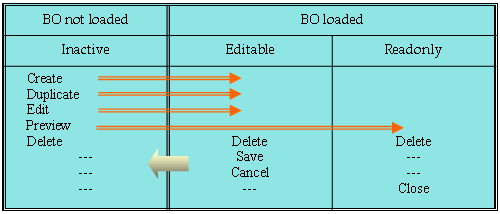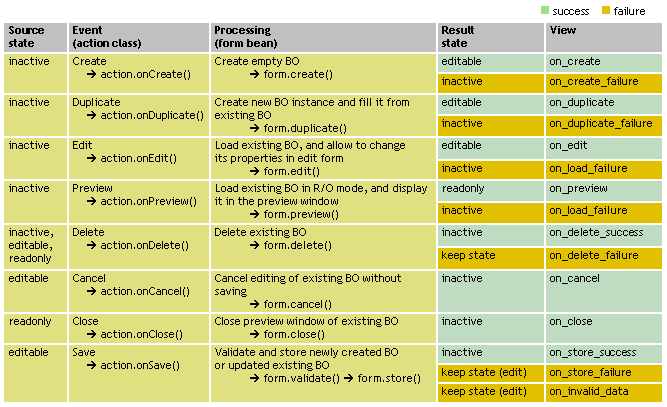Struts Dialogs: CRUDAction |  |
Overview
The purpose of CRUDAction is creating web controls for the common use case of an interactive application: creation, update and deletion of a business object (BO).
CRUDAction inherits from DialogAction and adds the following features:
- handler methods for CRUD events;
- states and state transitions for BO;
- mappings for result pages;
Events
The following table displays possible states of BO, and events, permissible for each state. A very common implementation is browsing a list of BOs (also called items), then selecting one item for preview or for editing. Viewing and editing is usually performed in a separate form. The same or similar form is usually used to create a new item.

Let us call an existing item, which is being viewed or edited, or a new item, which just has been created and is being filled out, a current item. In other words, current item is the item we currently work with.
If current item does not exist, CRUDAction is set to inactive state. It is possible to switch to one of the active states, by doing one of the following:
- Create new item from scratch and start populating its properties.
- Create new item duplicating its data from existing one, and change some of its properties.
- Edit existing item, updating some or all of its properties.
- View existing item in read-only mode.
- Delete existing item.
After we created a new item or started to edit an existing one, CRUDAction switches to one of the active states: editable or readonly. Editable state permits to update item data. Readonly state is used for preview mode and may help to optimize item caching.
After changes are stored or canceled, current item is deallocated, and CRUDAction is switched back to inactive state. Any further attempt to view or edit non-existing item will cause error.
States and transitions
The table below describes CRUDAction states, operations permissible in each state, and outcomes of each operation. Events are processed in action class by handler methods. These methods perform functions common to every event, like handling error messages and deciding which mapping to return. The actual data processing is done in the form bean.

Why business object is handled in the form bean? Should not all buseness operations be defined in an action class? Not really, because these methods logically belong to form bean.
- CRUDAction uses form bean to store both input and output data. This data is either updated from request, or is used to render output page. Online poll shows that about 60% of Struts developers use form beans for both input and output, so CRUDAction does not invent the wheel.
- CRUDAction implements two-phase I/O processing, where each data submission is split in two requests. Thus, a form bean must store intermediate data between requests.
Because of above, the purpose of form bean is elevated from simple transfer object populated by request data, to stateful interactive object. This object can be manipulated with methods, which are conveniently defined right in it. Each session receives its own copy of a form bean, and it is logical to process business events right where business data is stored.
A form bean must implement ICRUDForm interface. Event handlers in the CRUDAction correspond to business methods in ICRUDForm one to one. "Save" event is an exception, it consists of two steps: validate item data, and then persist item. Standard validate method of a form bean is used for validation.
In the same manner as validate method, all business methods of ICRUDForm interface return ActionMessages object. Non-empty object signifies an error. Upon completion, whether with errors or not, business methods update the state of BO and return to event handler. Then event handler decides where to go next.
Error Messages
CRUDAction employs two-phase I/O processing, so error messages are temporarily saved between requests by event handlers. Messages are removed from session automatically.
Business data
Because the form bean must implement ICRUDForm interface, it is unlikely that you will use dynabeans. You have to define a good old form bean extending ActionForm class. Recall that intermediate data should be stored in the form bean. This allows to populate it automatically from the request during input phase. To make this work, there are two main choices.
First approach is to define getters and setters for all properties of your business object right in the form bean. The example provided below uses this approach. Creating setters and getters is a tedious process, but it has its benefits.
- You can define all form bean properties as strings. This helps to retain entered values, even if they are incorrect, because no conversion to native type is made.
- You can use validate method provided by a form bean to check input data, and you do not need to worry about consistency of a real business object.
Another choice is to set up a BO as a property of the form bean. Struts will access it as nested property and will be able to set and read its internal fields. You will need to use qualifiers to access properties of a BO from JSP page. This choice makes sense in the following situation:
- Your business object accepts string values, and has built-in validation mechanism.
- The validation mechanism returns error messages, which can be converted to Struts ActionMessages.
Input and Output
CRUDAction uses the same two-phase processing model, as DialogAction which it inherits from.
Handler methods process input data, sent to the action in the first (POST) phase. They perform update of business object, update its state, generate error messages if needed, and then return to Struts with "reload mapping". The mappings are shown in the transition table in the two right columnts. They identify an action class, which would build and display a page. For all but very view applications all these mappings point back to the same action, which process CRUD events. See the sample source code.
Second phase (GET) is serviced by getView method. This method can be overriden, but in its standard form it should suffice for most applications. It does not do much except reading current state of business object:
- If item is editable, it forwards to edit page.
- If item is readonly, it forwards to preview page.
- If item is inactive, that is, it does not exist, then getView method forwards to error page, which should notify a user that item has expired. This may happen when a user leaves edit or preview form, and then clicks Back button. CRUDAction tries to prevent a user from viewing stale data.
The pages themselves should be designed by a developer of specific application. Edit page usually contains input fields and two buttons: "Save" and "Cancel". Preview page usually displays business data as text, and has "Close" button. Of course, these buttons should generate events which are defined in the transition table. You do not need to implement all handler methods or events. On the other hand, you can add new events or outcome mappings.
